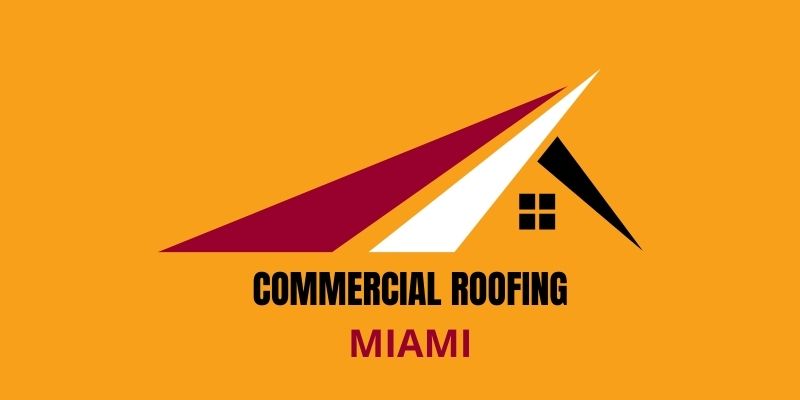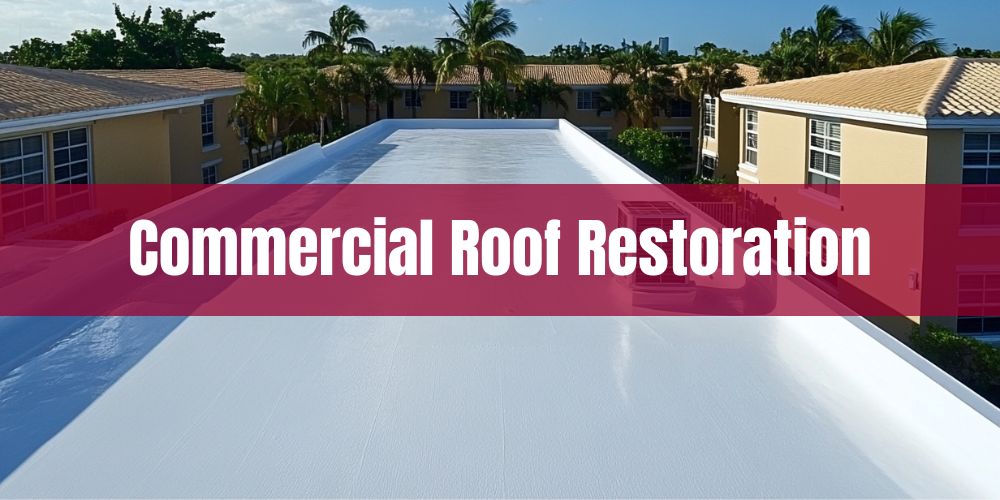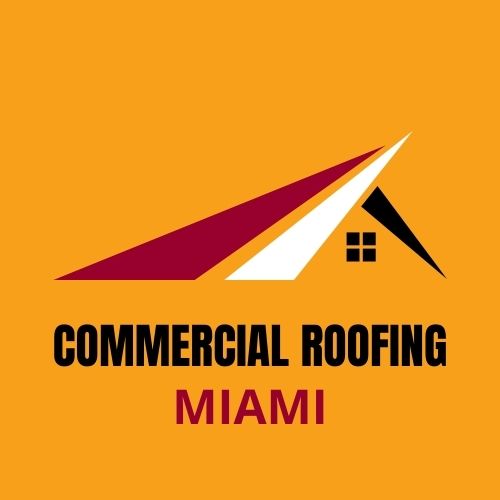Commercial roof restoration involves the process of renewing and extending the life of existing commercial roofing systems without replacing the entire roof. This is achieved through cleaning, repairing, and re-coating the roof to address issues such as leaks, weather damage, and wear and tear. The restoration process helps improve the roof's performance, enhances its appearance, and increases its energy efficiency. By opting for commercial roof restoration, businesses can save on costs, reduce environmental impact, and minimize disruption to their operations. Commercial Roofing Miami provide commercial roof restoration services across the Miami, Florida area.
What Is Commercial Roof Restoration?
Commercial roof restoration is a process designed to extend the life of existing commercial roofing systems by addressing issues such as leaks, damage, or deterioration rather than opting for a complete roof replacement. This process typically involves cleaning the roof surface, repairing damaged areas, and applying specialized coatings that enhance the roof's waterproofing and durability. It offers a cost-effective solution for maintaining the integrity of a roof while improving its energy efficiency. Additionally, commercial roof restoration helps meet sustainability goals by reducing waste generated from roof replacements. The coatings used in the restoration provide protection against harsh weather conditions, including UV radiation, and maintain a building's aesthetic appeal. Notably, roof restoration can add several years to the roof's lifespan without the significant expense and disruption of a full replacement.
Given Miami, Florida's high humidity, intense heat, and frequent rain, commercial roof restoration in this city places a strong emphasis on choosing coatings that are highly reflective and resistant to moisture. Installation methods often include spray-on or roll-on applications, which are quick to apply and can conform well to the unique shapes and details of Miami's diverse commercial buildings.
Have a question about an upcoming project?
What Are Essential Steps For Successful Commercial Roof Restoration In Miami?
A successful commercial roof restoration in Miami requires a thorough inspection, strategic planning, and use of quality materials. Given Miami's high humidity and hurricane-prone climate, it is crucial to ensure that the roof restoration process is both comprehensive and prepared for severe weather conditions. Employing experienced professionals and following a detailed restoration plan can provide durability and longevity to the roof.
- Initial Roof Inspection: Identify existing damage and assess the extent of repair needed.
- Climate-Adaptive Planning: Develop a restoration strategy considering Miami's climate and weather patterns.
- Material Selection: Choose durable, weather-resistant materials suitable for Miami’s climate conditions.
- Professional Execution: Hire experienced roofing experts for efficient restoration and application processes.
- Regular Maintenance: Establish a maintenance routine to prolong the roof's functionality and lifespan.
1. Initial Roof Inspection: Identify existing damage and assess the extent of repair needed
The initial roof inspection is a thorough examination of a commercial roof to uncover any present damage and evaluate the necessary repairs to ensure the building's integrity. A comprehensive roof inspection is crucial for successful commercial roof restoration in Miami, where the climate can exacerbate existing issues on a roof. Early identification and assessment of damage allow property managers to prioritize repairs, avoiding potential hazards and larger costs in the future. Detailing the type, location, and severity of each issue provides a roadmap for restoration efforts, ensuring that critical areas are addressed first to prevent further degradation. Additionally, understanding the full extent of existing damages aids in budgetary planning and resource allocation for the repair process. This proactive approach preserves the roof's lifespan and ensures the safety and efficiency of the commercial property it protects.
2. Climate-Adaptive Planning: Develop a restoration strategy considering Miami's climate and weather patterns.
Climate-adaptive planning involves creating strategies that enhance a commercial roof’s resilience to Miami’s unique climate challenges, such as heavy rainfall, humidity, and hurricane threats. Successfully restoring a commercial roof in Miami requires addressing the frequent and intense weather conditions characteristic of the area. By developing a strategy that anticipates these climate factors, building owners can ensure their roofing systems are better equipped to withstand potential damage from extreme weather events. Additional considerations include selecting roofing materials known for their durability in humid, storm-prone environments, and incorporating design elements that facilitate effective drainage and wind resistance. Regular maintenance and inspections are critical to swiftly identify and repair potential vulnerabilities before they escalate into significant issues. Investing in climate-adaptive strategies not only extends the roof's longevity but also provides peace of mind for property managers against Miami's volatile weather patterns.
3. Material Selection: Choose durable, weather-resistant materials suitable for Miami’s climate conditions.
Material selection involves choosing roofing materials that can withstand Miami’s heat, humidity, and frequent storms. Selecting the right materials is critical for successful commercial roof restoration in Miami due to the city’s unique climate challenges. The choice of weather-resistant materials safeguards the roof’s integrity against harsh sun, heavy rains, and high winds. Using materials such as modified bitumen or TPO, known for their durability and resistance to Miami's climate, can enhance the roof's longevity and performance. Regular assessments and maintenance ensure the materials remain in optimal condition, preventing premature degradation. Prioritizing durable and resistant materials not only extends a roof's life but also minimizes repair costs and operational disruptions.
4. Professional Execution: Hire experienced roofing experts for efficient restoration and application processes.
Professional execution involves employing skilled roofing professionals to ensure smooth and effective restoration and application procedures in commercial roofing projects. Engaging experienced roofing experts is a critical step in achieving successful commercial roof restoration in Miami, where the unique climate demands precision and expertise. Skilled professionals are equipped to handle the complexities of roof restoration, ensuring that the process is done efficiently and meets structural and regulatory standards. By utilizing seasoned roofing experts, commercial building owners in Miami can minimize risks of improper application and associated costs. These professionals bring a wealth of knowledge in dealing with Miami's climate challenges, ensuring restoration efforts are both durable and effective. This strategic choice not only preserves the integrity of the roofing system but also extends its lifespan, optimizing overall investment in property maintenance.
5. Regular Maintenance: Establish a maintenance routine to prolong the roof's functionality and lifespan
Regular maintenance refers to the ongoing inspection, cleaning, and minor repair of a commercial roofing system to preserve its performance and extend its serviceable life. In Miami, where roofs face intense UV exposure, high humidity, and seasonal storms, a structured maintenance plan is critical to protecting the building envelope. Proactive strategies include biannual inspections—especially before and after hurricane season—clearing debris from drainage systems, verifying sealant integrity at flashing points, and checking for membrane punctures or seam degradation. Addressing minor issues, such as reapplying sealants, patching localized membrane wear, or tightening mechanical attachments, prevents small defects from developing into major failures. This forward-thinking approach not only safeguards the roof from weather-induced stress but also helps property managers avoid costly emergency repairs and premature replacement.
How Does Miami's Climate Affect Commercial Roof Restoration Decisions?
Miami's unique climate heavily influences the materials and techniques used in commercial roof restoration. With frequent rain, high humidity, and intense sunlight, buildings require materials that can cope with heat and moisture, ensuring durability and efficiency for long-term use. Choosing the right materials and restoration methods can significantly impact the building's energy efficiency and lifespan in Miami's challenging environment.
- Moisture Resistance: Essential to protect against Miami's high humidity and frequent rainstorms.
- UV and Heat Reflection: Important to reduce heat absorption from intense sunlight exposure.
- Storm Durability: Necessary for withstanding tropical storms and hurricane conditions common in Miami.
- Waterproof Seals: Critical to prevent leaks and water damage during heavy rainfalls.
- Energy Efficiency: Enhances building performance by reducing cooling costs in hot climates.
1. Moisture Resistance: Essential to protect against Miami's high humidity and frequent rainstorms
Moisture resistance is the ability of a commercial roofing system to repel water and resist damage from high humidity and frequent exposure to rain, ensuring durability and longevity in Miami's challenging climate. A key factor affecting commercial roof restoration decisions in Miami is the persistent high humidity and frequent rainstorms, which require roof systems to have superior moisture resistance. Without proper resistance, roofs are susceptible to water infiltration, leading to potential structural damage and compromised building integrity. To enhance moisture resistance, selecting materials such as TPO, PVC, or modified bitumen with robust waterproofing properties is essential. Regular upkeep, including sealing seams and checking for leaks, ensures the roof continues to perform effectively against Miami's relentless moisture challenges. Incorporating moisture barriers and effective drainage systems further protects commercial buildings, extending the life of the roofing system and reducing repair costs.
2. UV and Heat Reflection: Important to reduce heat absorption from intense sunlight exposure.
UV and heat reflection in commercial roofing refers to the ability of roofing materials to reflect ultraviolet rays and heat from the sun, thereby minimizing the amount of heat absorbed by the building. Miami's climate, characterized by intense sunlight and high temperatures, necessitates effective UV and heat reflection in commercial roofing to mitigate excessive heat absorption. This quality is crucial in maintaining cooler internal temperatures, which helps to reduce the reliance on air conditioning systems and lower energy costs. Choosing materials with high reflectivity can significantly enhance a building's energy efficiency by reducing cooling loads. Cool roofing technologies, such as reflective coatings or membranes, are particularly beneficial in Miami's sunny environment. Regular maintenance and inspection of these roofing systems ensure optimal performance, allowing businesses to take full advantage of their reflective properties and prolong the roof’s lifespan.
3. Storm Durability: Necessary for withstanding tropical storms and hurricane conditions common in Miami.
Storm durability refers to the ability of a roofing system to endure the extreme weather conditions, such as high winds and heavy rainfall, encountered during tropical storms and hurricanes in Miami. Miami's climate, characterized by severe weather events, necessitates the selection of commercial roofing materials and systems that can withstand the intense forces of nature. Storm-resistant roofing ensures the safety and longevity of commercial buildings by preventing damage that can lead to costly repairs and disruptions. Enhanced storm durability can be achieved through the use of impact-resistant materials and secure fastening methods, which prevent roof components from becoming airborne during high winds. Regular maintenance checks help identify vulnerabilities that could be exacerbated during a storm, allowing for timely repairs and reinforcements. By investing in durable roofing solutions, businesses in Miami can protect their assets and minimize downtime in the aftermath of storms.
4. Waterproof Seals: Critical to prevent leaks and water damage during heavy rainfalls
Waterproof seals are essential components in commercial roofing systems designed to prevent water infiltration, thereby protecting the building's structure and interior from potential water damage during heavy rainfalls. Miami's climate, with its frequent heavy rainfalls and storms, makes the integrity of waterproof seals particularly crucial when considering commercial roof restoration. Ensuring effective waterproof sealing is vital in Miami's environment, where consistent exposure to intense weather conditions can lead to leaks and subsequent water damage if not properly addressed. Regular inspections and maintenance of waterproof seals are necessary to identify any potential vulnerabilities before they result in significant structural damage. Advanced sealing technologies, such as elastomeric coatings and high-performance sealants, can enhance the durability of these seals, providing greater resistance to weather-induced deterioration. Investing in quality waterproof seals not only prolongs the lifespan of the roof but also mitigates the risks associated with frequent and intense rainfalls commonly experienced in Miami.
5. Energy Efficiency: Enhances building performance by reducing cooling costs in hot climates.
Energy efficiency in commercial roofing refers to the capability of a roofing system to lower energy use by reflecting heat, which in turn reduces cooling costs and improves building performance in hot climates. Miami's hot climate necessitates the choice of energy-efficient roofing solutions to mitigate the high cooling demands faced by commercial buildings. This energy efficiency helps decrease dependency on air conditioning systems, providing substantial cost savings, and ensuring a comfortable indoor environment. Choosing energy-efficient roofing materials, such as modified bitumen with reflective coatings, is essential for maintaining indoor comfort and reducing energy expenditure. These roofs reflect more solar radiation, decreasing heat absorption and thus minimizing the heat transfer into the building. The implementation of such systems also decreases the urban heat island effect, promoting a sustainable and environmentally friendly approach to commercial roofing in hot climates like Miami.
What Are Cost-Effective Solutions For Commercial Roof Restoration In Miami?
A cost-effective solution for commercial roof restoration in Miami is applying roof coatings. Roof coatings not only extend the life of the existing roof but also improve energy efficiency by reflecting sunlight, reducing cooling costs. Additionally, selecting the appropriate materials for Miami’s climate is crucial to ensure durability and longevity.
- Roof Coatings: Extend roof lifespan and enhance energy efficiency by reflecting UV rays.
- Routine Maintenance: Regular inspections identify minor issues before they become costly repairs.
- Seam Reinforcement: Strengthen seams to prevent leaks and enhance structural integrity.
- Metal Roof Retrofit: Install a new metal layer over the existing roof to minimize replacement costs.
1. Roof Coatings: Extend roof lifespan and enhance energy efficiency by reflecting UV rays.
Roof coatings are protective layers applied to commercial roofing systems to reflect UV rays, enhance energy efficiency, and prolong the roof's lifespan by preventing degradation. Commercial buildings in Miami benefit from roof coatings as they provide a cost-effective solution for roof restoration by minimizing the impact of the sun's UV rays, thus preventing premature aging and damage. This reflection of heat not only preserves the condition of the roof but also reduces cooling costs, addressing the question of energy efficiency and roof longevity in Miami's climate. Applying high-performance coatings like silicone or acrylic can significantly enhance the durability of commercial roofs, making them robust against Miami's hot and sunny weather. Routine maintenance that includes checking the integrity of the coating ensures optimal performance over time, thereby keeping energy expenses low. Furthermore, by maintaining consistent roof temperature, coatings help mitigate thermal expansion and contraction, reducing the risk of leaks and structural issues.
2. Routine Maintenance: Regular inspections identify minor issues before they become costly repairs
Routine maintenance involves scheduled roof evaluations to spot and fix minor flaws, thereby preventing extensive and expensive damage. Implementing routine maintenance is a cost-effective solution for commercial roof restoration in Miami as it allows businesses to proactively address wear and tear due to the city’s humid and storm-prone climate. By identifying minor issues early, owners can avoid major repairs or premature replacements, which can be financially burdensome. Regular inspections are essential to detect problems such as small leaks, membrane punctures, or damaged flashing before they escalate into significant issues that require more intensive repairs. Establishing a maintenance routine helps ensure the roof remains resilient against the elements and prolongs its service life. Utilizing professional inspections at regular intervals is key to maintaining the overall health and performance of the roofing system.
3. Seam Reinforcement: Strengthen seams to prevent leaks and enhance structural integrity.
Seam reinforcement involves the use of materials and techniques to enhance the durability and watertightness of the joints in a roofing system, mitigating the risk of leaks and structural weaknesses. Addressing seam reinforcement is crucial for commercial roof restoration in Miami to combat frequent rain and humidity, which can exacerbate seam deterioration. This strategy ensures long-term waterproofing and structural stability, essential for protecting commercial investments and operations. Implementing seam reinforcement techniques can include using reinforced tapes, liquid sealants, or mechanical fasteners, which add longevity and resilience against environmental stressors. Regular inspections and maintenance focus on these vulnerable areas, detecting potential issues early and ensuring that any repairs are promptly addressed. By reinforcing seams, commercial roofs maintain their performance and integrity, avoiding costly water damage repairs and operational disruptions.
4. Metal Roof Retrofit: Install a new metal layer over the existing roof to minimize replacement costs.
A metal roof retrofit involves installing a new metal panel over an existing roof to enhance durability and extend the roof's lifespan. Metal roof retrofitting offers a cost-effective solution for commercial roof restoration in climates like Miami, where frequent storms and high humidity pose risks to traditional roofing systems. By adding a metal layer, businesses can protect their buildings from moisture ingress, reduce maintenance needs, and delay the full roof replacement. This technique not only minimizes disruption to business operations but also improves thermal efficiency and resistance to severe weather. The longevity and minimal maintenance requirements of metal roofs make them an attractive option for reducing long-term operational costs. Additionally, prefabricated metal panels can be quickly installed over existing roofing materials, providing a seamless and efficient upgrade.


